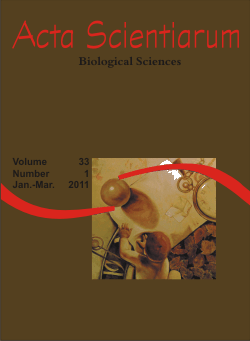<b>Soil seed bank during succession at an abandoned pasture in the upper Paraná river-floodplain, Brazil</b> - doi: 10.4025/actascibiolsci.v33i1.6391
Keywords:
riparian vegetation, invasive exotic species, environmental conservation areas, Psidium guajava
Abstract
We evaluated density and species composition of the soil seed bank in active pasture and in secondary forest on a 10 year-old abandoned pasture to identify changes in density, richness, diversity and species composition during secondary succession of abandoned pastures. The implications of those changes for the forest recovery process were also considered. Soil samples were collected at Porto Rico island, state of Paraná, in 2007. The seedling emergence method was used. Data on active pasture collected in 1996, published by Campos and Souza (2003) were used for comparative analysis. No evidence was found of a pattern of changes in density of the soil seed bank during succession of abandoned pastures. We observed increases in richness and diversity, in the contribution of tree and shrub species and dominance of herb species for the seed bank during the first 10 years of abandonment of pastures in riparian forests. At the end of succession, the soil used as pasture can result in systems that are different from the original environment, due to seed bank impoverishment and presence of exotic species.Downloads
Download data is not yet available.
Published
2011-02-08
How to Cite
Chapla, T. E., & Campos, J. B. (2011). <b>Soil seed bank during succession at an abandoned pasture in the upper Paraná river-floodplain, Brazil</b> - doi: 10.4025/actascibiolsci.v33i1.6391. Acta Scientiarum. Biological Sciences, 33(1), 59-69. https://doi.org/10.4025/actascibiolsci.v33i1.6391
Issue
Section
Ecology and Limnology
DECLARATION OF ORIGINALITY AND COPYRIGHTS
I Declare that current article is original and has not been submitted for publication, in part or in whole, to any other national or international journal.
The copyrights belong exclusively to the authors. Published content is licensed under Creative Commons Attribution 4.0 (CC BY 4.0) guidelines, which allows sharing (copy and distribution of the material in any medium or format) and adaptation (remix, transform, and build upon the material) for any purpose, even commercially, under the terms of attribution.
Read this link for further information on how to use CC BY 4.0 properly.
0.6
2019CiteScore
31st percentile
Powered by 

0.6
2019CiteScore
31st percentile
Powered by 











1.png)




3.png)













